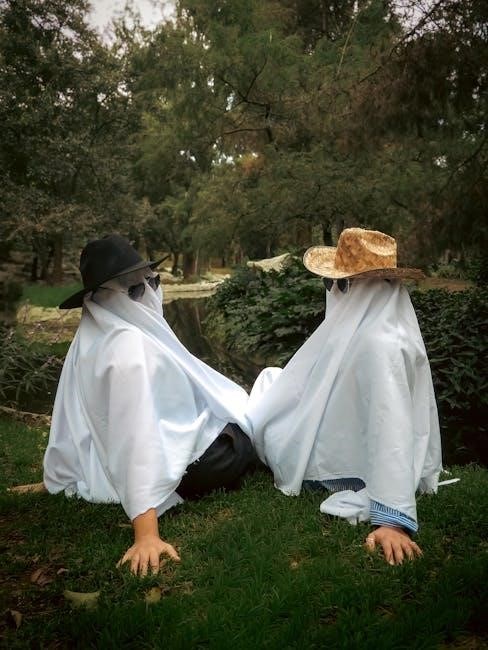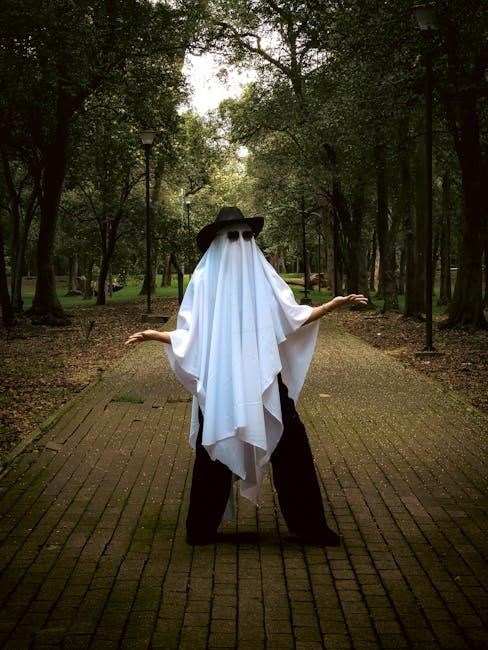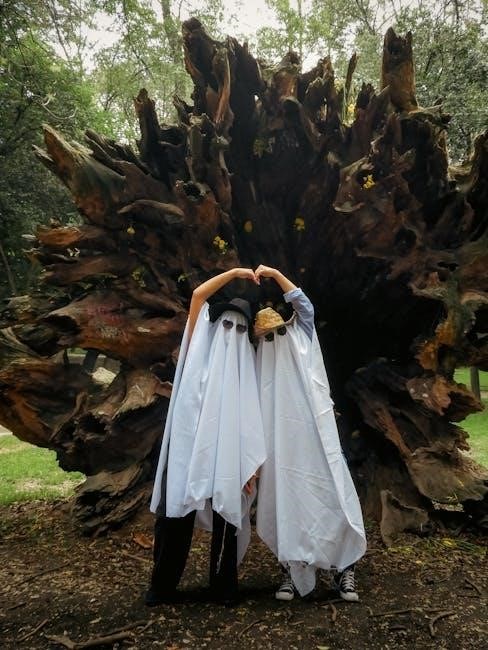The novel‚ set in the Paris Opera House‚ explores the haunting tale of a mysterious figure with physical deformities‚ blending love‚ obsession‚ and horror in a gothic masterpiece․

1․1 Overview of the Novel
The Phantom of the Opera‚ written by Gaston Leroux‚ is a gothic novel published in 1910․ It tells the story of a mysterious‚ disfigured musician who haunts the Paris Opera House․ The Phantom‚ a genius composer‚ falls in love with Christine Daaé‚ a young soprano‚ and becomes her mentor․ However‚ his obsession turns dangerous when Christine also attracts the attention of Raoul‚ the Vicomte de Chagny․ The novel explores themes of love‚ obsession‚ and isolation‚ set against the eerie backdrop of the opera house․ Its dark‚ atmospheric narrative and complex characters have made it a classic of gothic horror‚ captivating readers for over a century․
1․2 Historical Context and Background
Gaston Leroux’s The Phantom of the Opera is set in late 19th-century Paris‚ drawing inspiration from the city’s rich cultural and architectural history․ The novel is deeply rooted in the era’s fascination with the supernatural and the mysterious․ Leroux was influenced by real-life legends and architectural peculiarities of the Paris Opera House‚ blending fact and fiction to create a haunting atmosphere․ The story reflects the societal fears and romanticism of the time‚ while its gothic elements resonate with the literary trends of the early 20th century․ This historical backdrop adds depth to the narrative‚ making the Phantom’s tale both timeless and deeply tied to its era․
1․3 The Significance of the Paris Opera House Setting
The Paris Opera House is more than a backdrop in The Phantom of the Opera; it is a central character․ Its grandeur and hidden passages create a gothic atmosphere‚ mirroring the Phantom’s dual existence․ The Opera House’s real-life architectural peculiarities‚ such as underground tunnels and hidden chambers‚ inspired Leroux to craft a setting that blends reality and fantasy․ The opulent public spaces contrast with the dark‚ isolated areas beneath‚ symbolizing the Phantom’s own duality․ This setting not only heightens the novel’s eerie tone but also serves as a metaphor for the Phantom’s haunting presence and his control over the performers‚ making it integral to the story’s unfolding drama and suspense․

The Author and His Inspiration
Gaston Leroux‚ a French journalist and writer‚ drew inspiration from real architectural oddities of the Paris Opera House and its chilling legends to craft his gothic masterpiece․
2․1 Gaston Leroux: A Brief Biography
Gaston Leroux‚ born in 1868 and passing in 1927‚ was a French journalist and writer․ His career as a reporter influenced his detailed‚ suspenseful writing style․ Leroux gained fame with The Phantom of the Opera‚ published in 1910 as a serialized novel․ The story‚ set in the Paris Opera House‚ blends horror‚ romance‚ and mystery‚ becoming a gothic classic․ Leroux also wrote detective fiction‚ but The Phantom of the Opera remains his most enduring work‚ captivating readers with its haunting tale of love and isolation․ His legacy endures through numerous adaptations‚ solidifying his place in literary history․
2․2 Leroux’s Inspiration for the Phantom
Gaston Leroux drew inspiration for the Phantom from real architectural peculiarities of the Paris Opera House and chilling legends tied to its history․ The Phantom‚ a deformed man shunned by society‚ reflects Leroux’s fascination with isolation and the human condition․ His deformities and haunting presence were influenced by the opera house’s hidden passages and underground lake‚ creating a sense of mystery․ Leroux’s journalistic background allowed him to weave historical facts with gothic horror‚ crafting a compelling narrative․ The Phantom’s tragic search for love and acceptance adds depth‚ making him a sympathetic yet terrifying figure․ This blend of reality and fiction solidified the Phantom’s enduring appeal in literature and popular culture․
2․3 Real-Life Architectural Influences on the Story
The Paris Opera House’s real-life architectural features heavily influenced Gaston Leroux’s narrative․ The building’s underground lake and hidden passages inspired the Phantom’s lair‚ adding a layer of realism to the story․ Leroux incorporated the opera house’s grand staircase and chandelier‚ which became pivotal settings for key events․ The opulent design and labyrinthine structure of the building provided a gothic backdrop‚ enhancing the eerie atmosphere․ These architectural details not only grounded the story in reality but also amplified its mysterious and haunting elements‚ making the Paris Opera House a character in itself within the novel․

Main Characters and Their Roles
The Phantom‚ a disfigured musical genius‚ haunts the Paris Opera House․ Christine Daaé‚ his obsession‚ is a young soprano‚ while Raoul‚ her childhood lover‚ seeks to rescue her․
3;1 The Phantom: A Complex and Flawed Character
The Phantom‚ a disfigured musical genius‚ embodies a tragic duality of brilliance and terror․ His physical deformity and social isolation have shaped his psyche‚ driving him to seek acceptance through fear and control․ Despite his menacing presence‚ he is a deeply human figure‚ yearning for love and connection․ His obsession with Christine Daaé stems from a longing for understanding‚ yet his methods are morally ambiguous‚ blurring the line between villain and victim․ The Phantom’s complexity lies in his dual nature: a tortured soul and a master of manipulation‚ making him one of literature’s most compelling and flawed characters․
3․2 Christine Daaé: The Object of the Phantom’s Obsession
Christine Daaé‚ a young and talented soprano‚ becomes the focal point of the Phantom’s obsession․ Her innocence and vocal prowess captivate him‚ fueling his desire for her affection․ The Phantom sees Christine as his muse and potential savior‚ believing she can bring light into his dark existence․ However‚ his possessive nature and controlling behavior alienate her‚ driving her closer to Raoul․ Christine’s character represents purity and hope‚ contrasting the Phantom’s darkness; Her journey explores the tension between fear and compassion‚ as she grapples with the Phantom’s influence while seeking a life beyond the opera house․ Her role is central to the novel’s exploration of love‚ obsession‚ and redemption․
3․3 Raoul‚ the Vicomte de Chagny: Christine’s Lover and Rescuer
Raoul‚ the Vicomte de Chagny‚ is Christine Daaé’s childhood friend and romantic suitor․ He reenters her life as she gains fame at the Paris Opera House‚ determined to protect her from the Phantom’s grip․ Raoul’s love for Christine is genuine‚ and he resolves to rescue her from the Phantom’s obsession․ His bravery and loyalty are tested as he confronts the Phantom‚ navigating the dark secrets of the opera house․ Raoul represents hope and normalcy in Christine’s life‚ offering her a chance to escape the Phantom’s haunting influence․ His character embodies courage and devotion‚ making him a crucial figure in the story’s resolution and Christine’s ultimate liberation․
Themes and Symbolism
The novel explores themes of love‚ obsession‚ and the impact of physical deformity‚ delving into social isolation and the struggle between good and evil‚ set against the symbolic backdrop of the Paris Opera House․
4․1 The Theme of Love and Obsession
The Phantom’s unrelenting passion for Christine Daaé drives the narrative‚ showcasing love as both a redemptive and destructive force․ His obsession stems from a deep-seated longing for acceptance‚ distorted by years of isolation․ Christine‚ caught between the Phantom’s possessive adoration and Raoul’s romantic love‚ embodies the tragic consequences of such fixation․ The novel highlights how obsession can blur the lines between devotion and control‚ creating a complex interplay of emotions that fuels the story’s dark‚ gothic atmosphere․ This theme remains central‚ exploring the devastating effects of unrequited love and the lengths to which it can drive the human spirit․
4․2 The Impact of Physical Deformity and Social Isolation
The Phantom’s physical deformity and subsequent social isolation are central to his tragic character․ His disfigured appearance evokes fear and rejection‚ forcing him into the shadows of the Paris Opera House․ This isolation fuels his resentment and bitterness‚ shaping his actions as both a genius and a monster․ Leroux portrays the Phantom as a victim of societal prejudice‚ highlighting how physical appearance can dictate one’s fate․ His isolation intensifies his obsession with Christine‚ as he seeks acceptance and love in the only way he knows․ The novel underscores the devastating consequences of rejection‚ transforming the Phantom into a symbol of both horror and pity‚ trapped in a life of loneliness and despair․
4․3 The Struggle Between Good and Evil

The Phantom of the Opera explores the moral ambiguity of its titular character‚ blending elements of good and evil․ The Phantom‚ though flawed‚ exhibits a deep capacity for love and genius‚ yet his actions are often driven by malice and revenge․ His obsession with Christine Daaé highlights the fine line between devotion and possessiveness․ Society’s rejection of him due to his deformity fuels his darkness‚ making him both a victim and a villain․ This duality creates a tragic figure‚ evoking both fear and pity․ The novel challenges readers to question whether the Phantom is inherently evil or a product of circumstance‚ adding depth to the classic struggle between good and evil․
The Novel’s Legacy and Cultural Impact
The Phantom of the Opera remains a gothic masterpiece‚ influencing literature‚ film‚ and theater․ Its haunting tale continues to captivate audiences‚ ensuring its lasting cultural impact․
5․1 The Novel’s Reception Upon Publication
When first serialized in 1910 and published in 1911‚ The Phantom of the Opera received mixed reviews․ Critics found its dark themes and grotesque elements unsettling‚ yet the story’s intrigue captivated readers․ The novel’s gothic atmosphere and psychological depth resonated with audiences‚ despite initial skepticism․ Over time‚ it gained recognition as a gothic horror classic‚ praised for its complex characters and haunting narrative․ Its enduring popularity led to numerous adaptations‚ solidifying its place in literary history․ The novel’s ability to blend romance‚ horror‚ and tragedy continues to appeal to readers‚ making it a timeless tale of love and obsession․
5․2 The Phantom of the Opera as a Gothic Horror Classic
The Phantom of the Opera is widely regarded as a masterpiece of Gothic horror‚ blending eerie atmospheric settings with psychological complexity․ The Paris Opera House‚ with its hidden passages and underground lake‚ serves as a chilling backdrop‚ evoking a sense of mystery and dread․ The Phantom‚ a tragic and terrifying figure‚ embodies the duality of horror and sympathy‚ while his physical deformity and isolation amplify the novel’s dark themes․ The story’s exploration of obsession‚ love‚ and the supernatural aligns with Gothic traditions‚ making it a cornerstone of the genre․ Its enduring appeal lies in its ability to unsettle and captivate‚ solidifying its status as a timeless Gothic horror classic․
5․3 The Novel’s Influence on Literature and Popular Culture
The Phantom of the Opera has left an indelible mark on literature and popular culture‚ inspiring countless adaptations‚ including films‚ stage productions‚ and musicals․ The 1925 silent film starring Lon Chaney and Andrew Lloyd Webber’s iconic musical are testament to its enduring appeal․ The novel’s themes of love‚ obsession‚ and the supernatural have influenced writers and creators‚ shaping Gothic horror and romantic narratives․ The Phantom himself has become a cultural icon‚ symbolizing both terror and tragedy․ His story continues to captivate audiences‚ proving the novel’s timeless relevance․ Its availability in digital formats‚ such as PDF‚ ensures it remains accessible‚ inspiring new interpretations and keeping its legacy alive in modern times․
Adaptations and Interpretations
The Phantom’s tale has been reimagined in films‚ stage productions‚ and musicals‚ most notably the 1925 silent film and Andrew Lloyd Webber’s iconic musical‚ enduring cultural phenomena․
6․1 The 1925 Film Adaptation Starring Lon Chaney
The 1925 silent film adaptation of The Phantom of the Opera‚ starring Lon Chaney‚ is a landmark in cinematic history․ Chaney’s iconic portrayal of the Phantom‚ featuring his groundbreaking self-applied makeup‚ captivated audiences and solidified the character’s image in popular culture․ Directed by Rupert Julian‚ the film remains faithful to Gaston Leroux’s novel while adding its own dramatic flair․ Its success helped establish the story as a gothic horror classic‚ paving the way for future adaptations․ The film’s eerie atmosphere‚ combined with Chaney’s haunting performance‚ continues to inspire new generations of fans and filmmakers alike‚ ensuring its enduring legacy in cinema․
6․2 Andrew Lloyd Webber’s Musical Adaptation
Andrew Lloyd Webber’s The Phantom of the Opera musical‚ which premiered in 1986‚ is one of the most successful stage productions in history․ The adaptation captures the essence of Gaston Leroux’s novel‚ blending haunting melodies with dramatic storytelling․ The iconic score‚ featuring songs like “The Music of the Night” and “All I Ask of You‚” has become synonymous with the Phantom’s tragic tale․ The musical’s opulent sets and costumes bring the Paris Opera House to life‚ immersing audiences in the Phantom’s world․ Its enduring popularity has earned it numerous awards and a permanent place in theatrical history‚ making it a timeless interpretation of the novel’s gothic romance and horror․
6․3 Other Notable Adaptations and Interpretations
Beyond the iconic 1925 film and Andrew Lloyd Webber’s musical‚ The Phantom of the Opera has inspired numerous adaptations․ The 2004 film starring Gerard Butler and Emmy Rossum brought the story to a new generation‚ blending romance and horror․ Stage productions worldwide have reimagined the tale‚ with innovative sets and interpretations․ Literary reinterpretations‚ such as novels exploring the Phantom’s backstory‚ offer fresh perspectives․ These adaptations highlight the story’s versatility‚ ensuring its enduring appeal across mediums and audiences․ Each interpretation enriches the Phantom’s legacy‚ solidifying its place as a cultural icon․

The Novel in Digital Formats
The Phantom of the Opera is widely available as a PDF‚ offering readers convenience and accessibility․ Digital formats enhance readability‚ and popular platforms provide easy downloads․

7․1 The Availability of “The Phantom of the Opera” as a PDF
The Phantom of the Opera is readily available as a PDF‚ making it accessible to readers worldwide․ The novel can be downloaded from various platforms‚ including Amazon‚ Google Books‚ and Project Gutenberg․ Many editions are free or low-cost‚ ensuring affordability․ The PDF format preserves the original text’s integrity while offering adjustable font sizes and easy navigation․ Readers can enjoy the gothic tale on devices like e-readers‚ tablets‚ or smartphones․ This digital accessibility has introduced the classic to a new generation‚ maintaining its timeless appeal․ The convenience of the PDF ensures that Gaston Leroux’s masterpiece remains widely read and appreciated in the digital age․
7․2 The Advantages of Reading the Novel in Digital Format
Reading The Phantom of the Opera in digital format offers numerous advantages․ The PDF version allows for adjustable font sizes‚ making it easier on the eyes․ Portable devices enable reading anywhere‚ anytime‚ without the bulk of a physical book․ Digital copies often include search functions‚ enabling quick access to specific passages or themes․ Additionally‚ hyperlinks to footnotes or references enhance the reading experience․ The digital format also reduces storage space‚ making it ideal for libraries on-the-go․ Furthermore‚ annotations and bookmarks can be easily added‚ facilitating deeper engagement with the text․ These features make the digital version a convenient and flexible option for modern readers․
7․3 Popular Platforms for Downloading the Novel
Several platforms offer The Phantom of the Opera in PDF format‚ catering to diverse reader preferences․ Amazon provides the novel through its Kindle Store‚ ensuring easy access and a seamless reading experience․ Google Books often features preview versions‚ while Project Gutenberg offers the classic tale for free‚ as it is now in the public domain․ ManyBooks and Internet Archive are popular choices for downloading free e-books‚ including Leroux’s masterpiece․ These platforms allow readers to enjoy the story on various devices‚ making it convenient to carry the novel wherever they go․ The availability of the PDF format across these sites ensures that the story remains accessible to a global audience․
The Phantom of the Opera remains a timeless gothic masterpiece‚ its haunting story of love and horror continuing to captivate readers in PDF and digital formats․
8․1 The Timeless Appeal of “The Phantom of the Opera”
The Phantom of the Opera captivates readers with its haunting blend of romance‚ horror‚ and tragedy․ The novel’s exploration of universal themes like love‚ obsession‚ and isolation resonates deeply‚ transcending time and culture․ The Phantom‚ a complex and sympathetic character‚ evokes both fear and pity‚ making him one of literature’s most enduring figures․ The atmospheric setting of the Paris Opera House‚ with its gothic architecture and hidden secrets‚ adds to the story’s mystique․ As a PDF‚ the novel remains accessible‚ allowing modern readers to experience Gaston Leroux’s masterpiece․ Its timeless appeal lies in its ability to evoke emotions and spark reflection‚ ensuring its place as a classic in both literature and popular culture․
8․2 The Novel’s Enduring Legacy in Modern Times
Gaston Leroux’s “The Phantom of the Opera” continues to captivate modern audiences‚ its legacy evident in various adaptations and interpretations․ The novel’s gothic themes and complex characters have influenced literature‚ film‚ and theater․ As a PDF‚ the story remains widely accessible‚ introducing new generations to the Phantom’s haunting tale․ Its exploration of love‚ obsession‚ and identity resonates in contemporary culture‚ making it a timeless classic․ The novel’s ability to adapt across mediums while retaining its core emotional depth ensures its enduring relevance․ Its impact on popular culture‚ from musicals to films‚ underscores its lasting influence‚ solidifying its place as a cornerstone of gothic horror and romantic tragedy․

8․3 Final Thoughts on the Novel’s Impact and Relevance
“The Phantom of the Opera” remains a gothic masterpiece‚ its themes of love‚ obsession‚ and isolation continuing to resonate with modern audiences․ The novel’s exploration of human complexity and the blurred lines between good and evil ensures its relevance․ Its influence on literature‚ theater‚ and film is undeniable‚ with adaptations like Andrew Lloyd Webber’s musical cementing its place in popular culture․ The availability of the novel as a PDF has made it accessible to new generations‚ ensuring its enduring legacy․ Leroux’s work not only reflects the fears and desires of its time but also speaks to universal human experiences‚ solidifying its status as a timeless classic in both literary and cultural landscapes․

